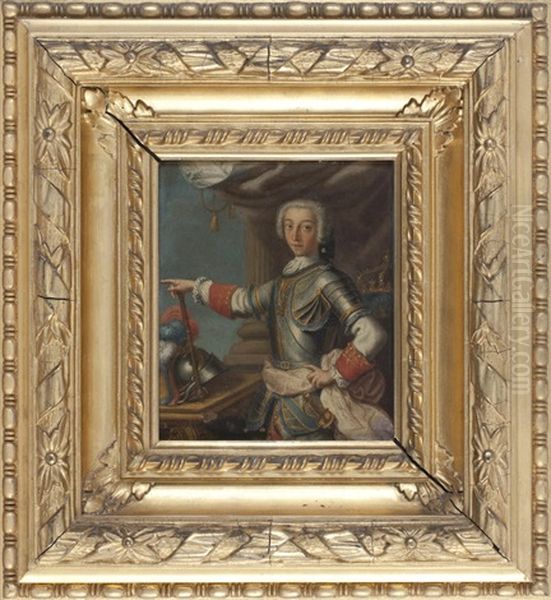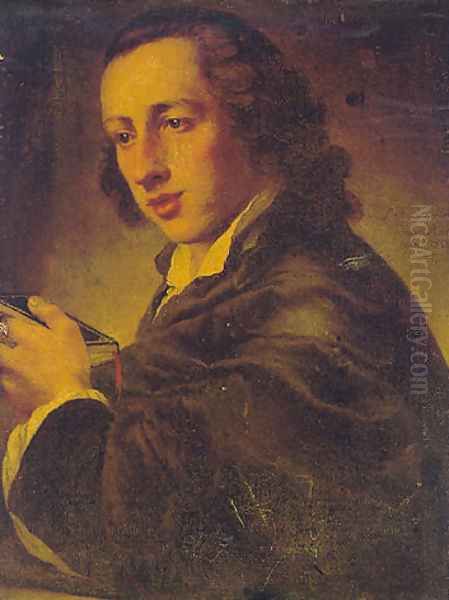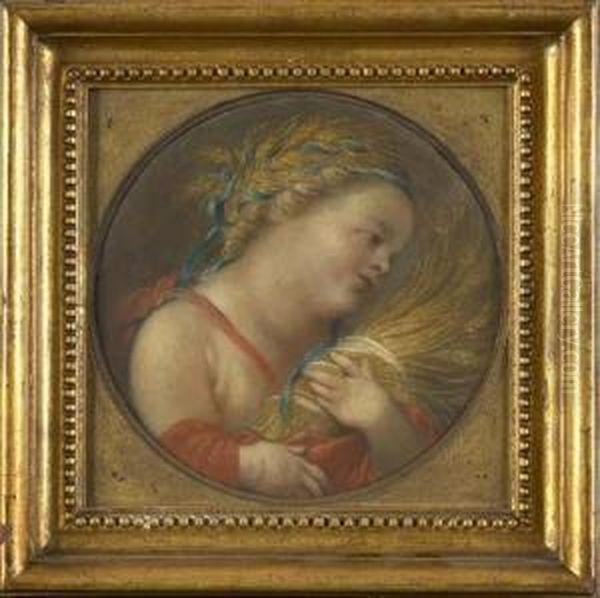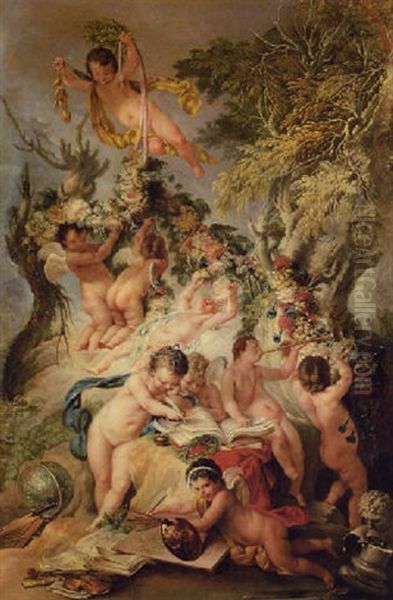Louis Gabriel Blanchet (1705-1772) stands as a significant, if sometimes overlooked, figure in the constellation of 18th-century European painting. A French artist who spent the majority of his productive career in Rome, Blanchet carved a niche for himself primarily as a portraitist, adeptly capturing the likenesses of the era's elite, including Grand Tourists, ecclesiastical figures, and exiled royalty. His work, characterized by a refined elegance and a keen psychological insight, reflects the rich artistic crosscurrents of his time, blending French sensibilities with the pervasive influence of the Roman art scene.
Early Life and the Call of Rome
Born in Paris in 1705, not Versailles as some earlier accounts suggested, Louis Gabriel Blanchet's early life was nonetheless connected to the French court, as his father served as a valet de chambre to King Louis XIV. This proximity to the pinnacle of French culture may have instilled in him an early appreciation for the arts. His formal artistic training led him to compete for the prestigious Prix de Rome, a scholarship awarded by the French Royal Academy of Painting and Sculpture that allowed promising young artists to study in Italy.
In 1727, Blanchet achieved a significant milestone by securing the second prize in the Prix de Rome competition. This accolade was his passport to the Eternal City, the ultimate destination for any aspiring artist of the period. Rome was not just a city; it was a living museum, a vibrant hub where the legacy of antiquity and the Renaissance converged with contemporary artistic practice. For a young French painter, it offered unparalleled opportunities for study, inspiration, and patronage.
The French Academy in Rome and Artistic Milieu
Upon his arrival in Rome, Blanchet became a pensionnaire at the Académie de France à Rome, then housed in the Palazzo Mancini on the Via del Corso. The academy was under the directorship of Nicolas Vleughels (1668-1737), a distinguished painter in his own right, who played a crucial role in shaping the experiences and training of the French artists under his charge. Vleughels fostered an environment that encouraged both rigorous study of the masters and the development of individual talent.

It was here that Blanchet formed a close association with Pierre Subleyras (1699-1749), another exceptionally talented French painter who had won the first prize in the Prix de Rome the same year Blanchet won second. The two artists became roommates and colleagues, sharing experiences and likely influencing each other's artistic development. Subleyras would go on to achieve great fame for his religious and historical paintings, as well as his portraits, becoming one of the most sought-after artists in Rome. Blanchet is known to have assisted Subleyras on some of his major commissions, including the monumental Dinner in the House of Simon (1737, Musée du Louvre, Paris) and the Mass of Saint Basil, demonstrating a collaborative spirit within the competitive environment of the academy.
The French Academy was a melting pot of talent. Besides Subleyras, Blanchet would have interacted with other French artists, such as Edouard Boudin, who was also a resident during part of Blanchet's early years in Rome. Later, Charles-Joseph Natoire (1700-1777) would become the director of the Academy (from 1751), overseeing a new generation of French artists, though Blanchet by then was an established independent master. The artistic environment in Rome was further enriched by painters from across Europe, including Italian masters like Pompeo Batoni (1708-1787) and the German Neoclassical pioneer Anton Raphael Mengs (1728-1779), both of whom became dominant figures in Roman portraiture, particularly for the Grand Tour market.
A Celebrated Portraitist: Capturing the Grand Tour
While Blanchet also produced historical and religious paintings, such as his The Vision of Constantine, it was in the realm of portraiture that he truly excelled and built his reputation. Rome in the 18th century was a key stop on the Grand Tour, an educational rite of passage for young European noblemen and wealthy commoners, especially the British. These travelers were eager to commemorate their visit with souvenirs, and a portrait painted by a Roman artist was among the most coveted.
Blanchet became a favored portraitist for these discerning clients. His style was well-suited to their tastes, offering a blend of French elegance, Rococo charm, and a dignified Roman gravitas. He was adept at capturing not only a physical likeness but also the character and status of his sitters. His portraits often feature rich fabrics, carefully rendered details of costume and accessories, and settings that might allude to the sitter's interests or their Roman experience.
His clientele included prominent French and British visitors. For instance, he painted members of the entourage of the Duc de Saint-Aignan, the French ambassador to the Holy See. These included French mathematicians and young aristocrats from Lyon, showcasing his connections within the French expatriate community.
Royal Commissions: The Exiled Stuarts

A particularly notable aspect of Blanchet's portraiture career was his engagement with the exiled Stuart court in Rome. After the Glorious Revolution of 1688 and subsequent Jacobite failures, Rome became a haven for the displaced British royal family. James Francis Edward Stuart, the "Old Pretender," and his sons, Charles Edward Stuart ("Bonnie Prince Charlie" or the "Young Pretender") and Henry Benedict Stuart (later Cardinal Duke of York), maintained a court in exile.
Blanchet was commissioned to paint several portraits of the Stuarts. Among his most famous works is the Portrait of Prince Charles Edward Stuart (c. 1738-1740s, often cited as 1739 or later). This iconic image, and others like it, played a crucial role in Jacobite propaganda, presenting the young prince as a charismatic and legitimate heir to the British throne. These portraits were often copied and distributed among supporters. Blanchet's depiction of Charles Edward Stuart typically conveys a sense of regal bearing, youthful confidence, and perhaps a touch of melancholy appropriate to his exiled status. He also painted Henry Benedict Stuart, capturing the different personalities of the two brothers. These commissions placed Blanchet in the orbit of significant political and dynastic currents of the era.
Artistic Style and Key Works
Blanchet's artistic style evolved throughout his career but consistently displayed a sophisticated handling of paint, an elegant sense of composition, and a nuanced approach to color. His early works show the influence of his French training, with a Rococo lightness and attention to delicate detail. His prolonged stay in Rome, however, imbued his art with a more classical sense of form and a richer, sometimes more somber, palette, aligning him with the prevailing Roman taste.
His style is often described as a fusion, incorporating the rich colors reminiscent of some Italian Mannerist traditions with the grandeur and formality expected in French official portraiture of the era, albeit softened by a more intimate Rococo sensibility. He was a master of capturing textures – the sheen of silk, the softness of velvet, the glint of metal – which added to the verisimilitude and luxuriousness of his portraits.
Beyond the Stuart portraits, other key works illustrate his skill:
Portrait of a Gentleman (c. 1740s): This work, likely representing a Grand Tourist, showcases Blanchet's ability to convey personality and status through pose, costume, and expression. The handling of light and shadow (chiaroscuro) is often subtle yet effective in modeling the form and highlighting the face.

Portrait of William Rouet: This painting is an excellent example of Blanchet's capacity to create a portrait that speaks to the sitter's intellectual pursuits. Rouet, a Scottish scholar, is depicted in an academic setting, surrounded by books and other attributes of learning, reflecting the Enlightenment's emphasis on knowledge.
Série des Quatre Saisons (Four Seasons series), including Spring and Summer (1759): While primarily a portraitist, Blanchet also ventured into allegorical and mythological subjects. This series demonstrates his versatility and his ability to engage with classical themes, depicting them with a characteristic grace and charm. These works would have allowed for a more imaginative use of composition and color than the constraints of formal portraiture.
His color palette could be both vibrant and restrained. In some portraits, he employed striking contrasts, such as deep reds, whites, and blues, to create a sense of drama or opulence. In others, a more muted and harmonious range of colors lends an air of quiet dignity. His treatment of light was consistently skillful, used to define form, create atmosphere, and draw the viewer's attention to the sitter's face and hands.
Influence and Legacy
Louis Gabriel Blanchet was part of a vibrant international community of artists in Rome. He was a contemporary of, and competed with, major figures like Pompeo Batoni and Anton Raphael Mengs, who largely dominated the Grand Tour portrait market. While perhaps not achieving the same level of widespread international fame as Batoni or Mengs in their lifetimes, Blanchet maintained a successful practice and was highly regarded for the quality and refinement of his work. Other notable portraitists active in Rome during this period included the Swiss painter Angelica Kauffman (though she arrived later in the century) and the Scottish painter Gavin Hamilton, who was also an important antiquarian and history painter.
Blanchet's influence extended to artists who encountered his work in Rome. His technique of outdoor sketching, reportedly using black and white chalk or pencil on blue-grey paper, is said to have influenced landscape painters, including the Welsh artist Richard Wilson, who spent time in Italy, and the Danish painter Johan Mandelberg. This practice, aimed at capturing natural light and topographical accuracy, was becoming increasingly important for landscape artists.

His connection with Pierre Subleyras was undoubtedly formative. While Subleyras achieved greater renown for large-scale religious compositions, both artists shared a sensitivity in portraiture. Blanchet's work can also be seen in the context of other French portraitists of the era, such as Jean-Marc Nattier, known for his elegant depictions of the French aristocracy, or Maurice Quentin de La Tour, a master of pastel portraiture. Though working in a different milieu, Blanchet shared their concern for capturing both likeness and social grace.
Later Years and Enduring Reputation
Louis Gabriel Blanchet remained in Rome for the rest of his life, continuing to paint and contribute to the city's artistic life. He never returned to France to be officially received (agréé) into the Royal Academy in Paris, which might have limited his recognition in his home country compared to contemporaries who pursued careers centered there, like François Boucher or Jean-Honoré Fragonard. However, his decision to stay in Rome cemented his role as a key figure in the Franco-Roman art world of the 18th century.
He died in Rome in 1772. His oeuvre, though perhaps not as vast or as widely dispersed as some of his contemporaries, remains a testament to his skill and artistry. His portraits, in particular, offer valuable insights into the society, culture, and personalities of the 18th century. They are prized by museums and private collections for their aesthetic quality, historical significance, and the intimate glimpse they provide into the lives of those who shaped the era.
While the grand narratives of art history often focus on the titans who dramatically shifted artistic paradigms, figures like Louis Gabriel Blanchet are essential for a complete understanding of an artistic period. He was a master craftsman, a sensitive observer of human character, and an artist who successfully navigated the competitive and cosmopolitan art world of 18th-century Rome. His legacy lies in the quiet elegance and enduring appeal of his portraits, which continue to engage viewers centuries after they were created, securing his place as a distinguished French painter of the Roman school. His dedication to his art, particularly in the specialized field of Grand Tour and aristocratic portraiture, ensures his continued appreciation by art historians and connoisseurs alike.